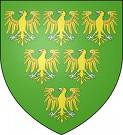In this post, I'll focus on the history of Scarborough. There is evidence of a fortification of some sort at Scarborough going back almost 3,000 years. It's in an ideal position, high up on solid rock that faces the North Sea. The Romans built a fort there in the 4th Century. The site was ideal for a signal station. You can still see a mock signal station there when you visit.
It seems the first castle was built by William le Gros, the then Earl of York. In 1155, Henry II took control of the castle, and it was he who built the great tower. The tower overlooked the growing town, the North Sea and most important, anyone approaching the castle. It was an impressive fortress. His son, King John, added some royal lodgings and another great hall, but these had fallen into disuse by the 14th century and had been turned into the castle kitchens, brewhouse and bakery. The only remaining stretch of curtain wall still standing was also built by King John between 1202 to 1212.
The view of the castle from the bottom of the town - it's a steep climb!
The great tower built by Henry II. It contained a chapel, great hall and private chambers for the king.
The current barbican and gatehouse were built in around 1300. The walls are about 5.5 metres. Outside of these walls there was ditch. Once entering the castle through the barbican, there was another gatetower with 2 drawbridges, both with a portcullis.
The remains of the well at Scarborough Castle.
The gatehouse and curtain walls before you reach the great tower.
By the time Piers Gaveston took shelter in to Scarborough Castle, it was ideal for a long term siege. However, Edward II and Piers had been surprised by an attack on the royal baggage train whilst at Newcastle, and both escaped by boat with whatever they could. It was not ideal preparation for a long term siege, and after 2 weeks, Piers surrendered on very favourable terms - including the promise of being allowed to return to Scarborough Castle and prepare for a siege. I'm sure we've all seen films/documentaries with castle under attack using trebuchets and siege towers. I've been fortunate enough to see the trebuchet at Warwick castle being fired. It was amazing!
A model of a wooden siege tower. It took time to build and could be easily burned down.
The working trebuchet at Warwick castle, which is usually fired twice a day.
Attackers could also try to dig and undermine castle towers, use catapults and battering rams, whilst they themselves were under attack from the castle. far more common were castle sieges that could last for months. What was required was a castle stocked with provisions - food obviously being the most important. Sieges could often last for up to six months, and during that time, the besieging lords would have to supply their men with wages, food and ale - a very expensive, and often futile attempt, to capture a castle and it's occupants. This is what Piers would surely have been hoping for. But for the disaster of Newcastle, Piers may well have had time to dig in for a long siege.
4 days ago









4 comments:
Why am I not surprised that the best part of the castle was built by Henry II? The great castle builder :) Anyway, I was happy to learn more about the castle's rich history :) Interesting post.
Hi Kasia - yes, Henry came up trumps again - and John's part fell into a ruin! Says it all ;)
Haha! That was a bit cruel ;) :) But hard not to come to similar conclusions :)
The truth will out Kasia;)
Post a Comment